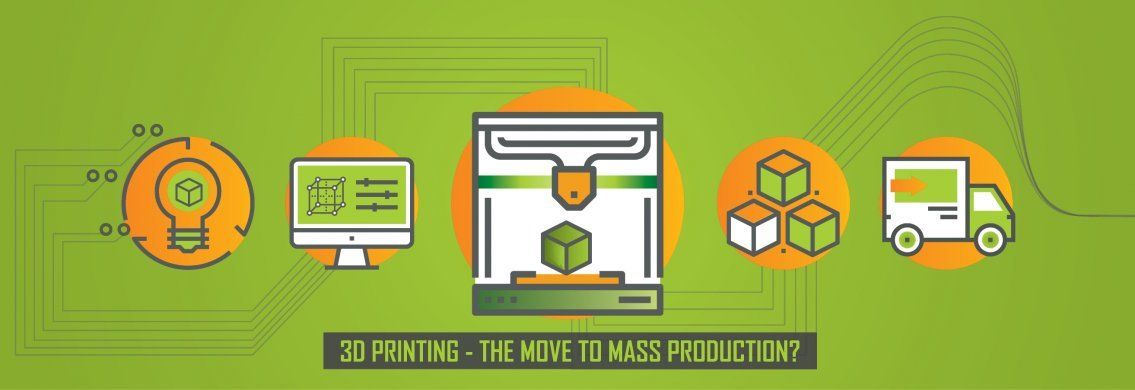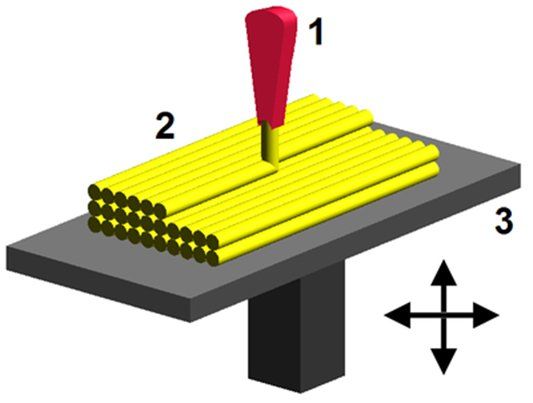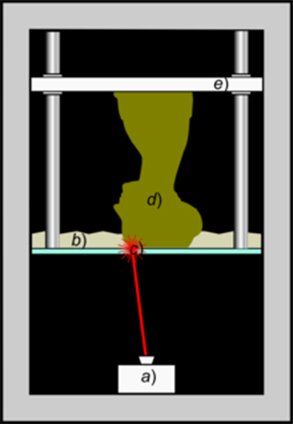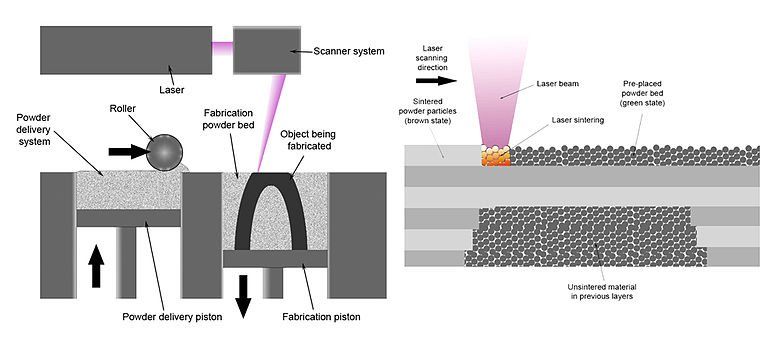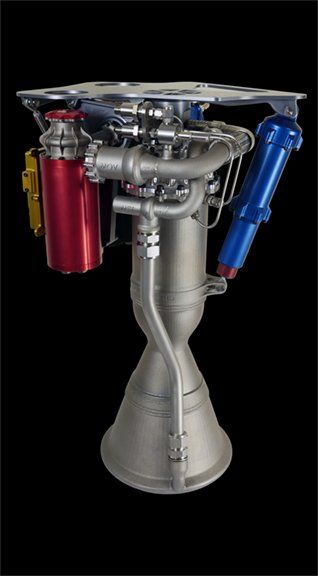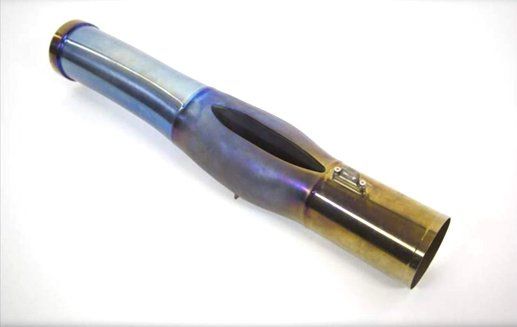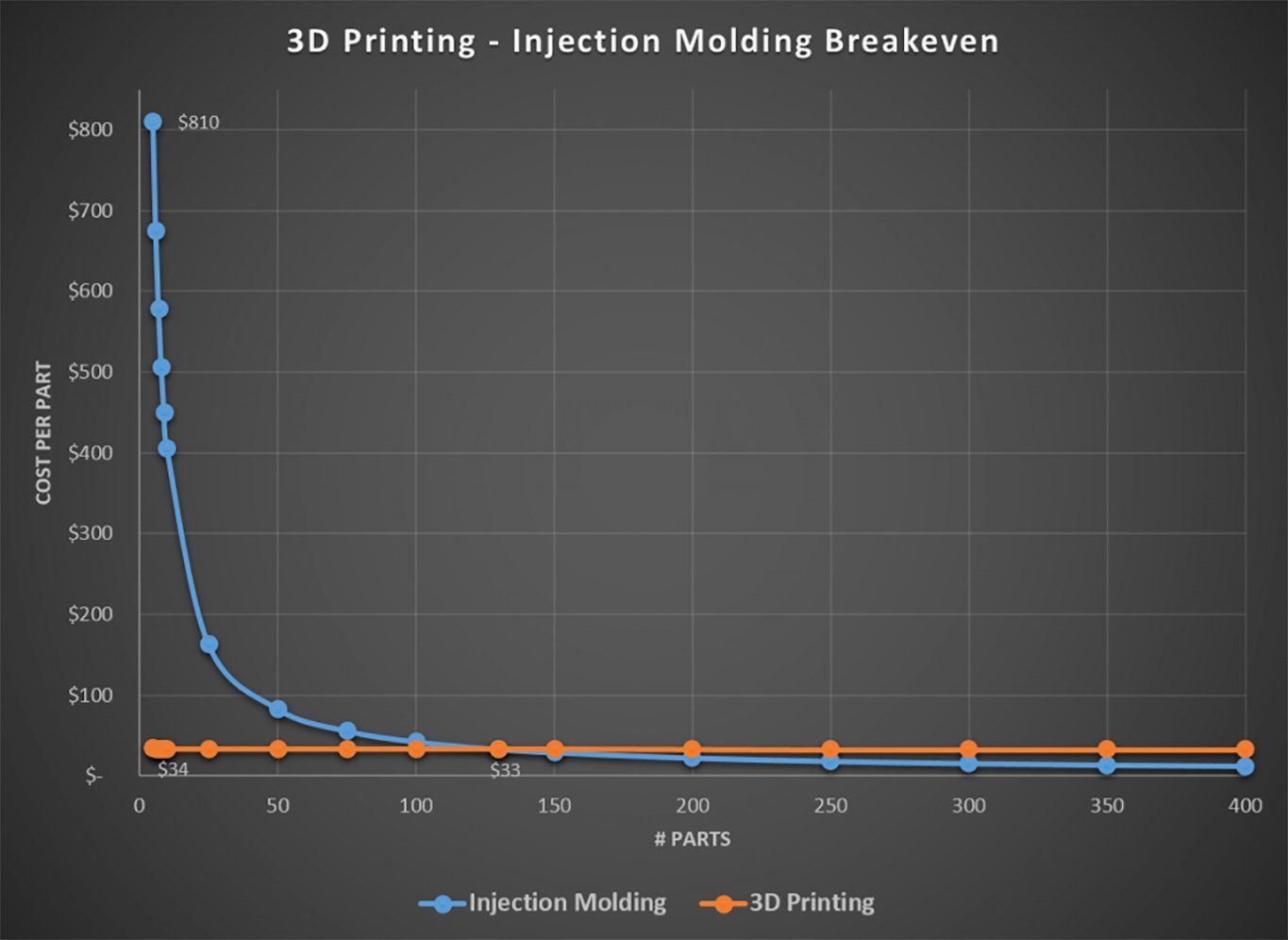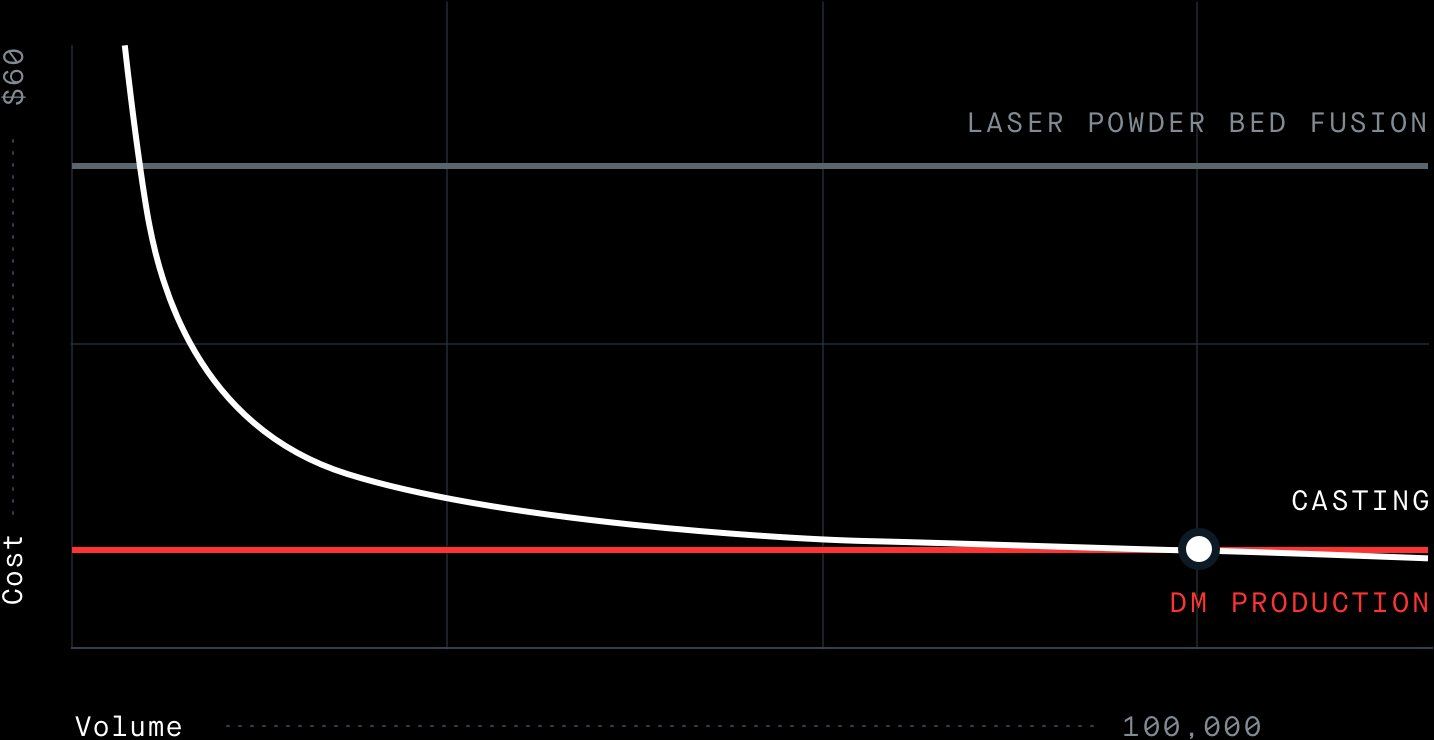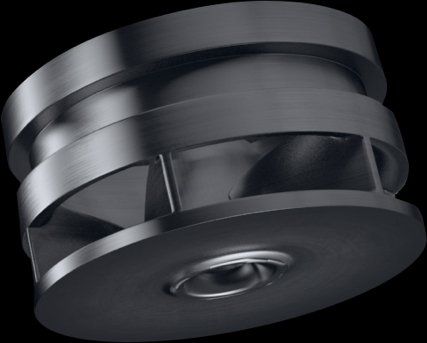3D Printing - The Move to Mass Production?
Date: May 3, 2018
Introduction:
The core technology of “3D Printing” or “Additive Manufacturing” has been around for almost four decades (the early 1980s), but it wasn’t until the advent of low cost Fused Deposition Modelling (FDM) in the late 2000s which really brought about the democratization of 3D Printing. This increased accessibility of 3D Printing generated a huge amount of public and journalistic interest which resulted in 3D Printing becoming one of the most hyped emerging technologies. This brought with it wildly optimistic forecasts of overnight wholesale changes to the manufacturing sector. Now, five years on from the peak 3D Printing hype, it is clear that 3D Printing has fallen short of the rosier predictions.
This blog will focus on how 3D Printing may now finally be shifting from the prototyping/ development space to becoming a viable manufacturing method at scale.
Before we investigate this, for those that are not familiar with 3D Printing, here are a few of the core printing technologies commonly used today.
Fused Deposition Modelling (FDM):
In essence, Fuse Deposition Modelling is a hot glue gun (known as the extruder) mounted to a 3-axis platform. The extruder moves around the build plate (base of the printer) ejecting molten plastic wherever material is required, this step is repeated layer by layer – see image below.
Common FDM materials:
- Polylactic Acid (PLA)
- Acrylonitrile Butadiene Styrene (ABS)
- High-Impact Polystyrene (HIPS)
Figure 1 – Image showing the layer by layer application of plastics [1]
Stereolithography (SLA):
Stereolithography, simply put, makes use of a liquid material (resin) which is selectively hardened by a movable laser beam. The liquid resin becomes solidified at the points where light from the laser beam shines on the surface, this laser will generally be in the Ultraviolet end of the light spectrum. As with FDM (or virtually any 3D Printing method), this is done with a layer by layer approach.
Common SLA Materials:
- Materials for SLA machines will usually be proprietary to the printer manufacturer due to the dependence on the wavelength of the UV laser used for curing.
Figure 2 - Image shows the workings of SLA printing. UV laser solidifying layer by layer [2]
Selective Laser Sintering (SLS):
Selective Laser Sintering, as the name suggests, uses lasers to selectively fuse (sinter) material together. Unlike SLA, the raw material is a fine powder and the fusing is achieved by thermally bonding powders together using a high-power laser. For the layer by layer process, a roller or slider applies a thin layer of powder after each z-axis increment. SLS is one of the most commonly used methods for engineering applications due to both the range of materials and its mechanical properties.
Common SLS Materials:
- Steel
- Titanium
- Nickel Alloy
- Stainless
- Aluminium
- Inconel
- Nylons
Figure 3: SLS printing system with laser-based sintering [3]
Low Volume Production
3D Printing as a tool for assisting with prototyping, conceptual evaluation, and integration testing has been commonplace in several large industries such as airspace and automotive for at least the last 20 years. More recently though, high value and low volume industries have been shifting towards making direct use of 3D printed parts in their final product. This is particularly noticeable in industries such as the Commercial Space arena and Formula One. Companies such as Space X and the New Zealand based Rocket Lab are believed to make extensive use of 3D printed components, this even extends to components which require a high degree of mechanical integrity.
An example of this is the Rutherford engine which Rocket Lab claims to use 3D printed parts for “all primary components” [4].
Figure 4: Rocket Labs’ 3D printed Rutherford engine [4]
There are numerous advantages to using 3D Printing as a final production part, these are outlined below:
- Greater design freedom, allowing for extremely intricate parts to be designed e.g. internal cavities and support structures which would be impossible when using conventional manufacturing methods.
- Extremely fast design iterations.
- Low tooling costs.
- Reduced amounts of waste material (additive vs subtractive manufacturing).
Like the Commercial Space industry, Motorsport (in particular Formula One) has moved from not only printing components for their internal wind tunnel models and prototypes but rather printing components get used directly on the race track. It was estimated in 2015 that Formula One teams were using between 40 to 60 3D printed components per race car [5]. This number of 3D printed components used on Formula One cars is likely to have risen since then, with rumours circulating that Ferrari may, in fact, be using 3D printed engine pistons.
Figure 5: Formula One exhaust with 3D printed components [5]
Scaling to Medium Volume Production
As previously mentioned, 3D Printing is a fantastic technology for low volume and high-value production. However, when scaling to higher volumes and smaller profit margin products, 3D Printing as a production solution has in the past been too expensive. The main driver of high production cost is related to the printing speeds [10], where a component that may take (say) a few seconds to make in an injection mould, could take anywhere from tens of minutes to several hours using conventional SLS, SLA or FDM methods. Hence medium to high (1,000 - 100,000) volume 3D Printing production in most cases is economically unviable-even when taking into consideration the significant overhead cost of the tooling needed for injection moulding.
The conventional break-even point for injection moulding (vs 3D Printing) can be anywhere between 50-500 units (Depending on many factors, including component size, shape, and complexity). The graph below shows an example of a bracket printed in nylon using conventional SLS vs Injection moulding in polyamide nylon [6]:
Figure 5: Injection Moulding vs 3D Printing Breakeven [6]
The cost comparison given in Figure 5 details the large overhead cost (~$800) inherent in the injection mould tooling (shown in blue) with an exponential price drop as the tool cost become less significant. In this particular case, the break-even point is ~130 parts at a price of $33 per unit. This would make the case that conventional SLS 3D printers are not sufficiently fast/cost effective as a medium-to-high volume production tool.
Fortunately, technology is forever evolving and 3D Printing (still being in its infancy) is showing plenty of development potential. Siemens in 2014 predicted that 3D Printing machines would become 400% faster in the coming five years [10]. However, according to claims made by several large 3D Printer companies, developing new 3D Printing methods such as Carbon 3D, Desktop Metal, and HP the advances may, in fact, have been significantly higher. The claimed speed improvements made by these companies vary between 10 to 100 times (1000-10,000%)* faster than conventional methods and since printing speed correlates to the final component cost, this could bring significant cost savings.
*Note: These are marketing claims and presently there is a lack of data to give a good indication on its validity.
The following section will take a closer look at two of these 3D Printer Companies.
HP Jet Fusion:
HP in recent years has taken its printing business to a new dimension with the addition of a Z-axis! HP made a move into the 3D Printing space around one year ago with the launch of its Jet Fusion printing system. The new Jet Fusion system is an interesting new plastic 3D Printing method which even includes multi-colour printing. Its approach is a blend of 3D SLS printing and conventional 2D inkjet printing. The plastic powder is evenly distributed over the build platform (as with SLS) and is then followed by an ink jet like nozzle, distributing fusing and detailing agent which ensure only the desired sections become “fused” together. Finally, the powder and fusing agent is thermally fused together - see Figure 6 below:
With this new approach, HP has made significant improvements in both the print speed and component cost. In fact, HP is claiming its print speeds are around 10 times faster and are about half the cost of conventional FDM and SLS printers. Below is a graph (from HP) broadly showing how their printing system shifts the break-even point (to conventional manufacturing i.e. injection moulding) to ever higher part quantities.
Desktop Metal:
Desktop Metal’s new metal 3D Printing production system (multi-staged approach forming and sintering) - due to be released in 2019 - makes some extremely impressive claims. Printing speeds are claimed to be “up to 100 times faster” than that of conventional laser-based systems (SLS). Additionally, part cost being reduced by around 20 x compared to today’s metal 3D Printing systems [9]. According to an example given by Desktop Metal, their production system could bring the break-even point (when compared with metal casting methods) of up to 100,000 units - see the graph below:
Figure 8 – Comparison of Conventional SLS (grey), Casting (white) and Desktop Metals Production system (red) [9]
This particular comparison was based on a water pump impeller which has some fairly intricate details (see image below) and therefore is likely to be more favourable to 3D Printing than casting. Component complexities aside, the component price for this water pump impeller is stated to be ~$4/unit which makes this an extremely promising system [9]. The method in which Desktop Metal achieve this is similar to HP’s approach and I would recommend taking a look!
Figure 9: Desktop Metals comparison impeller [9]
Conclusion
With the advancements made by the likes of HP, Carbon 3D, and Desktop Metal, the 3D Printing industry is now finally approaching a point where 3D Printing may, in fact, become a genuine economically viable alternative to conventional manufacturing methods. This certainly looks to be the case at medium-volume production and even high-volume production in some cases, such as the “water pump impeller” example given by Desktop Metal. However, high-volume production will likely remain limited to intricate/complex components where conventional production methods have astronomical high tooling costs. The move to use 3D Printing as a production tool is likely to bring significant benefits to the manufacturing sector, including:
- Reduced design cycle time
- Reduced manufacturing tooling cost
- Reduced manufacturing setup
- Potential for personalized customization – with virtually zero cost
- Simplified production automation
Finally, the proliferation of 3D Printing for manufacturing is good news for small-medium sized businesses with ambitious plans but the limited financial capacity to invest in expensive production tooling.
Here at Beta Solutions, we continue to use 3D printing as an effective method for rapid prototyping and are excited about the developments being made in this space. We continue to follow it closely and are always looking for ways in which the latest technological developments can be best applied to our clients' needs.
You can get in touch with us to discuss any idea you have in mind via our contact page or give us a call.
References
- [1] Retrieved from - https://en.wikipedia.org/wiki/Fused_filament_fabrication
- [2] Retrieved from - https://en.wikipedia.org/wiki/Stereolithography
- [3] Retrieved from - https://en.wikipedia.org/wiki/Selective_laser_sintering
- [4] Retrieved from - https://www.rocketlabusa.com/news/updates/rocket-lab-reveals-first-battery-powered-rocket-for-commercial-launches-to-space/
- [5] Williams, N. (2018) Sauber Motorsport AG and Additive Industries: Formula 1® engineering meets metal AM. (Pg. 91). Retrieved from http://issuu.com/inovar-communications/docs/magazine_metal_am_spring_2018_pdf_s?e=32443561/59440823
- [6] Retrieved from - https://www.xometry.com/blog/3d-printing-vs-injection-molding-breakeven/
- [7] Retrieved from - http://www8.hp.com/us/en/printers/3d-printers.html - Technical White Paper
- [8] Retrieved from - https://www.google.co.nz/imgres?imgurl=http%3A%2F%2Fwww.www8-hp.com%2Fus%2Fen%2Fimages%2Fvideo-poster-reinvent-3_tcm_245_2243684.jpg&imgrefurl=http%3A%2F%2Fwww8.hp.com%2Fus%2Fen%2Fprinters%2F3d-printers.html&docid=0o1lRPaz3GKcGM&tbnid=8rlDguz8v-XjIM%3A&vet=10ahUKEwjB24ycuOnaAhWCNpQKHcS1B_oQMwihAShTMFM..i&w=900&h=493&bih=949&biw=1920&q=hp%203d%20printing&ved=0ahUKEwjB24ycuOnaAhWCNpQKHcS1B_oQMwihAShTMFM&iact=mrc&uact=8
- [9] Retrieved from - https://www.desktopmetal.com/products/production/
- [10] Retrieved from - https://www.siemens.com/innovation/en/home/pictures-of-the-future/industry-and-automation/Additive-manufacturing-facts-and-forecasts.html
- [11] Retrieved from - http://www.metal-am.com/wp-content/uploads/sites/4/2018/03/MAGAZINE-Metal-AM-Spring-2018-PDF-dp-1.pdf


